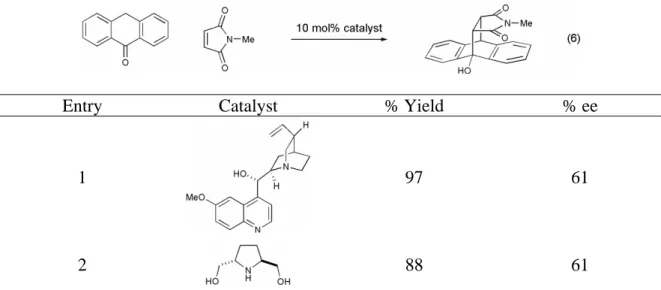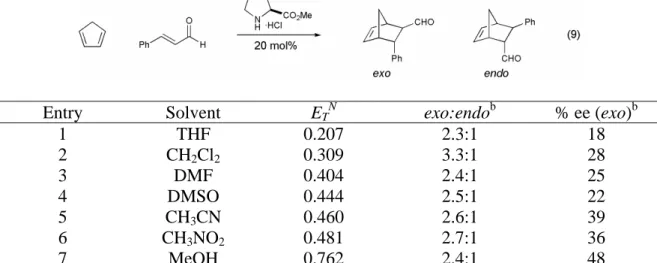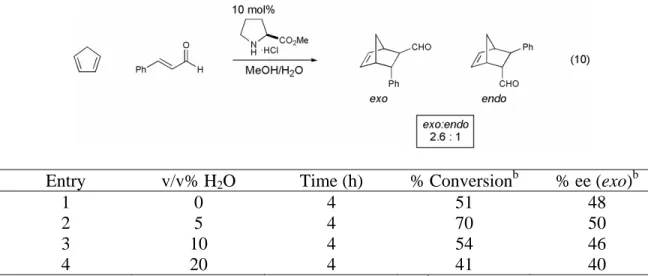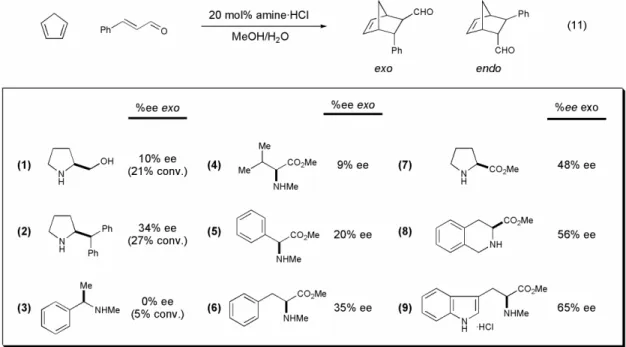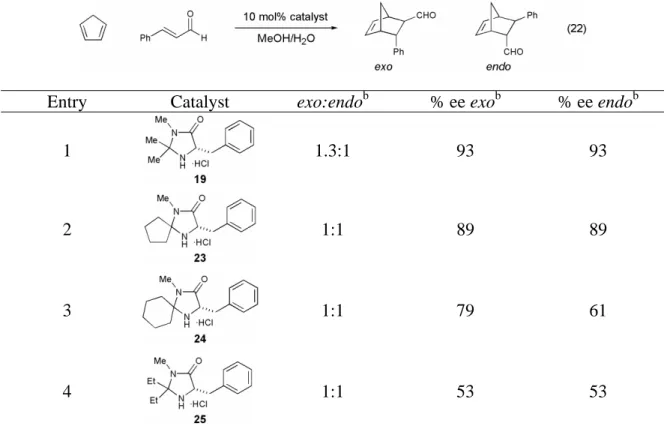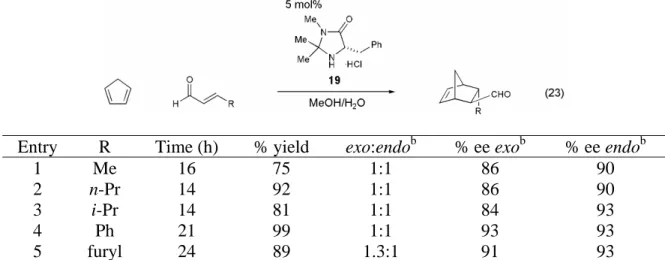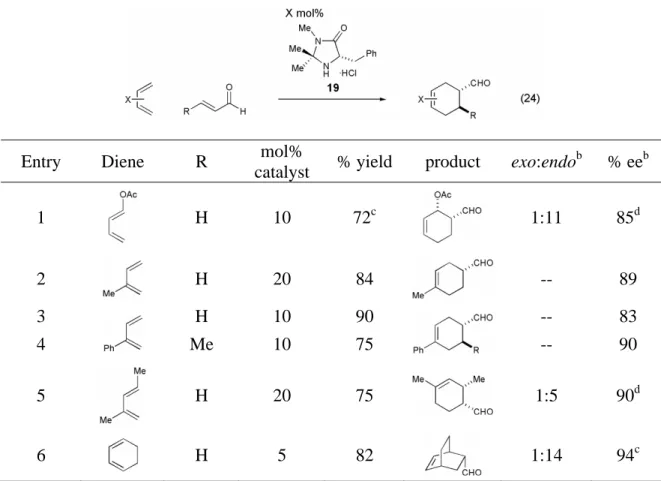Historically, the normal electron demand Diels-Alder reaction has been the most studied and utilized.10. Classification of Diels-Alder reactions based on the energy of the frontier molecular orbitals involved. 15 If the frontier molecular orbitals involved in a normal electron demand Diels Alder cycloaddition are calculated (the HOMO of the diene and the LUMO of the dienophile in a normal electron demand Diels-Alder reaction), and orbitals of similar sign and magnitude are allowed to interact, the regiochemistry of the Diels-Alder is correctly predicted (Scheme 2).
Only three examples of small molecule organocatalysis of the Diels-Alder have been reported prior to the study detailed in this thesis. This showed that the amine-catalyzed Diels-Alder reaction was significantly accelerated relative to the thermal background reaction. Initial studies on the organocatalytic Diels-Alder reaction were carried out with varying ratios of acid to free amine.
Solvent effect on proline methyl ester catalyzed Diels-Alder cycloaddition between cyclopentadiene and cinnamaldehyde.a. Effect of water concentration on proline methyl ester catalyzed Diels-Alder cycloaddition between cyclopentadiene and cinnamaldehyde.a. All initial investigations of the organocatalytic Diels–Alder reaction were performed at a concentration of 1.0 M relative to the limiting reagent.
All primary amines studied were poor catalysts of the Diels–Alder reaction, showing both low conversions and selectivities (data not shown).
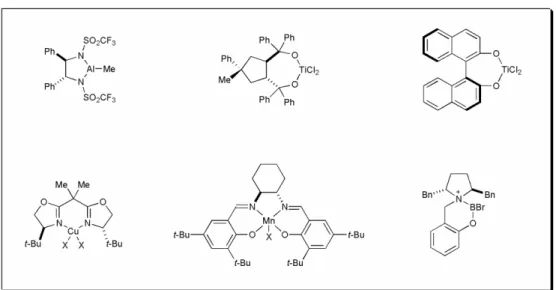
Calculated iminium ion structures for the iminium ion formed from proline methyl ester
The geometry of each of the two iminium ions leads to preferential cycloaddition via opposite enantiofaces of the reactive olefin. The iminium ion with the lowest calculated energy (8) correctly predicts the observed sense of enantio-induction (9), indicating that the geometry of the iminium ion plays an important role. A similar study was performed with the most selective catalyst discovered, abrin (Scheme 6).32 An iminium ion formed from an α,β-unsaturated aldehyde and abrin can also form with one of two possible geometries, one with the reactive olefin oriented trans to the chiral center of abrin (10) and one with the reactive olefin oriented cis to de.
These two iminium ions are also calculated to have different heats of formation, and each iminium ion protects a different p-enantioface of the reactive olefin. This leads to the formation of a different product enantiomer from each reactive iminium ion, and the calculated lowest energy iminium ion (11) correctly predicts the observed sense of enantioinduction (12). These two calculations suggest that the geometry of the reactive iminium ion is the controlling factor in determining the sense of enantioinduction observed in the organocatalytic Diels–Alder reaction.
The dense energy of the iminium ions calculated in each case (about 2 and 3 kJ·mol-1, respectively) suggests that both iminium ion geometries are intermediates in the cycloaddition. In an attempt to improve the selectivity of the process, studies were carried out on the control of iminium ion geometry. C2-symmetric catalysts were synthesized to test the importance of iminium ion geometry control as an important element in enantiocontrol.
The ideal catalyst for use in the organocatalytic Diels-Alder reaction should form only one iminium ion and completely block one π-enantioface of the reactive olefin. This catalyst must rapidly form iminium ion, and it must be easily accessible from inexpensive, readily available chiral starting materials. With these design factors in mind, we investigated the sterics of catalyst architecture as a means of iminium ion geometry control.
Molecular modeling of this catalyst chemotype showed that it would be possible to select for one iminium ion geometry by taking advantage of steric interactions within the catalyst substrate adduct (Scheme 8).32 By placing a geminal dimethyl group in the 2-position on the imidazolidine. -4-one ring, the reactive olefin is split into one of the two possible iminium ion geometries. The calculated energy difference between the two possible iminium ion geometries is nearly 10 kJ·mol-1, indicating the importance of this steric interaction. Molecular modeling also suggested that a benzyl group in the 5-position would be properly placed to fully protect one π-enantioface of the reactive olefin.
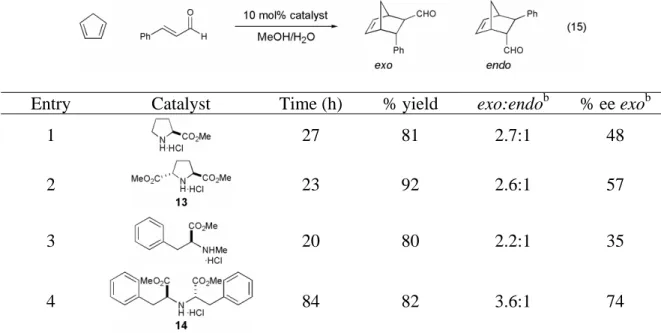
MM3 calculations predict 2,2-dimethyl-imidazolidin-4-ones to be effect organocatalysts for the Diels-Alder transformation
Synthesis of imidazolidinone catalysts
Variants of the benzylimidazolidinone catalyst 19 were synthesized with different geminal dialkyl substituents in an attempt to improve the exo:endo ratios in the organocatalytic Diels–Alder reaction. Investigation of geminal dialkyl substituents on the benzylimidazolidinone-catalyzed Diels-Alder reaction between cinnamaldehyde and cyclopentadiene.a. With an optimized organocatalyst for the Diels–Alder reaction identified, the ability of imidazolidinone 19 to catalyze a series of cycloadditions was investigated.
This is in contrast to the Lewis acid-catalyzed Diels-Alder reaction, which is most often carried out at -78 °C and is always carried out in a dry atmosphere. We first examined the variation of the α,β-unsaturated aldehyde component of the Diels-Alder reaction (Table 8). Changes in the steric demand at the β-position of the α,β-unsaturated aldehyde were well tolerated (Table 8, entries 1-4), and the reaction is also tolerant to aromatic α,β-unsaturated aldehydes (Table 8, entries 4 and 5).
The organocatalytic Diels–Alder reaction was also shown to be general with respect to the diene component of the reaction (Table 9). It was shown that less reactive dienes in addition to cyclopentadiene undergo the Diels-Alder cycloaddition in good yields and excellent selectivities (72-90% yield, 83-94% ee). 2,4-Hexadiene (28) was found to have insufficient reactivity to participate in the organocatalytic Diels–Alder reaction with acrolein, the most reactive dienophile studied.
At the other end of the spectrum, the 1,4-diaminodiene (29) tested was found to be too reactive for the organocatalytic Diels-Alder reaction conditions, oligomerizing almost immediately when introduced into the acidic reaction medium. Further studies conducted in the MacMillan lab by Catharine Larsen have shown the benefit of varying the acidity of the co-catalyst used in the catalyst. The stereochemistry observed in the organocatalytic Diels-Alder reaction is consistent with the calculated iminium ion (Scheme 10).
The ( E )-iminium ion isomer is enhanced by the presence of the geminal dimethyl substitution on the imidazolidinone framework, and this control over the geometry of the iminium ions properly positions the reactive olefin to have an enantioface protected by the benzyl group at the 5-position. . This combination of control elements effectively shields the new olefin face and allows cycloaddition to occur on the exposed Si face. The calculated imidazolidinone-derived iminium ion predicts the enantioselectivity of the organocatalytic Diels-Alder reaction.
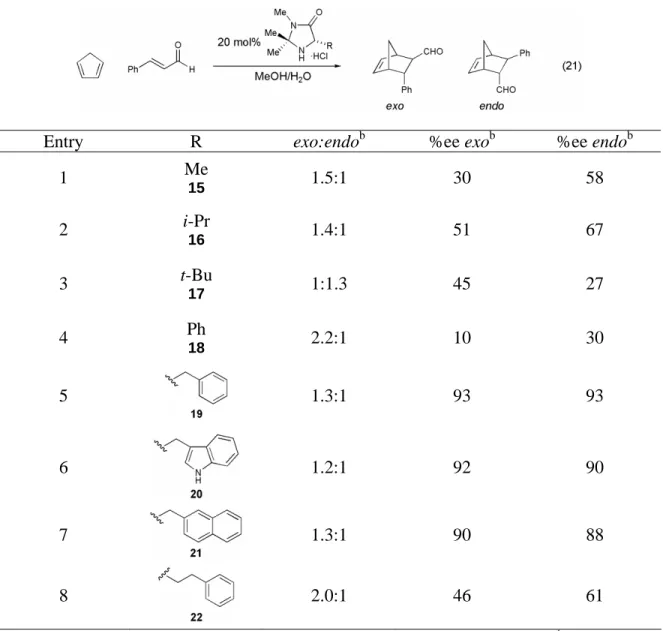
The calculated imidazolidinone-derived iminium ion predicts the enantioselectivity of the organocatalytic Diels-Alder reaction
Conclusion
Using a chiral imidazolidinone salt, Diels-Alder cycloadducts of α,β-unsaturated aldehydes and dienes can be achieved in good yields and high selectivities. The methodology developed has demonstrated the utility of a chiral secondary amine to function as a catalyst in a manner similar to Lewis acid catalysts, namely, through LUMO-lowering catalysis. This finding indicates that organocatalysis should be possible for a wide variety of chemical transformations, including transformations that are not possible using Lewis acid catalysis.
Experimental Section
The progress of the Diels-Alder reaction was typically monitored by TLC analysis, or where necessary, 1H NMR analysis of the reaction in situ in deuterated solvents or by GLC analysis of the reaction fractions. 2S, 5S)-pyrrolidine-2,5-dicarboxylic acid hydrochloride dimethyl ester (13). A solution of phenylalanine methyl ester hydrochloride (26.0 g, 121 mmol) and ethanolic MeNH2 (8.0 M, 60 mL) was stirred at room temperature until the amino ester was consumed as determined by TLC (20 h). After removing the organic solvents in vacuo, the residue was suspended in Et2O and then concentrated.
The solution was refluxed for 18 hours, cooled to room temperature and then concentrated in vacuo. The precipitate was recrystallized from isopropanol to give colorless crystals of the title compound in 59% overall yield from phenylalanine methyl ester hydrochloride (18.1 g, 71 mmol). After consumption of the limiting reagent, as judged by TLC, 1 H NMR or GLC analysis, the reaction mixture was diluted in ether (10 mL) and.
The endo isomer showed spectral data identical in all respects to those reported. 45 Diastereomeric ratios were determined by 1H NMR analysis. The yield of 72% was determined by comparing the peak areas of 6-formyl-cyclohex-2-enyl ester of acetic acid and 1,4-dimethoxybenzene. The product showed spectral data identical in all respects to that reported for acetic acid 6-formyl-cyclohex-2-enyl ester.47 The enantiomeric excess was determined by GLC analysis on a Bodman Γ-TA column (100 ° C, 1 ml/min). ) tr = 34.0 min and 47.9 min.
The absolute configuration of the title compound was determined after oxidation to 4-methyl-3-cyclohexene-1-carboxylic acid and correlation of the optical rotation with the reported value. Product ratios were determined by HPLC analysis after conversion to the corresponding alcohol (Chiralcel OD-H column, 6% isopropanol in hexanes, 1 mL/min); tr = 16.2 and 20.4 min. Conversion of the aldehyde to the corresponding alcohol was accomplished with excess NaBH4 in MeOH.
The solution was stirred for 31 hours and then passed through a silica plug with 3 ml of methylene chloride. The solution was then concentrated and purified by silica chromatography (10% EtOAc/hexanes) to provide 85 mg of the (R,R)-2,4-pentanediol acetal as a colorless oil (75% yield); 5:1 endo:exo; endo adduct 88% ee. The product exhibited spectral data identical in all respects to those previously reported.45 Enantiomeric excess was determined by GLC analysis on a Bodman Γ-TA column (70 °C initial temp, 3 °C/min gradient, 23 psi) tr = 24.0 min and 24.9 min.
The solution was stirred until TLC analysis judged that the diene was completely consumed. The solution is stirred at 10 °C until it is estimated by TLC analysis (24 h) that the aldehyde is completely consumed.
